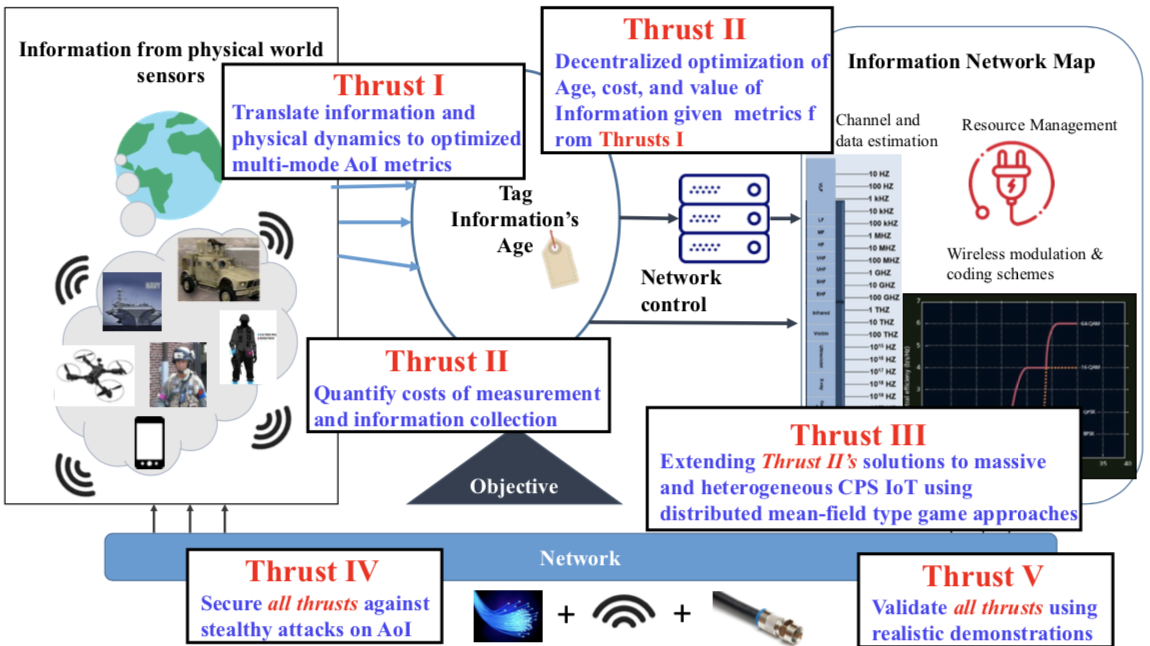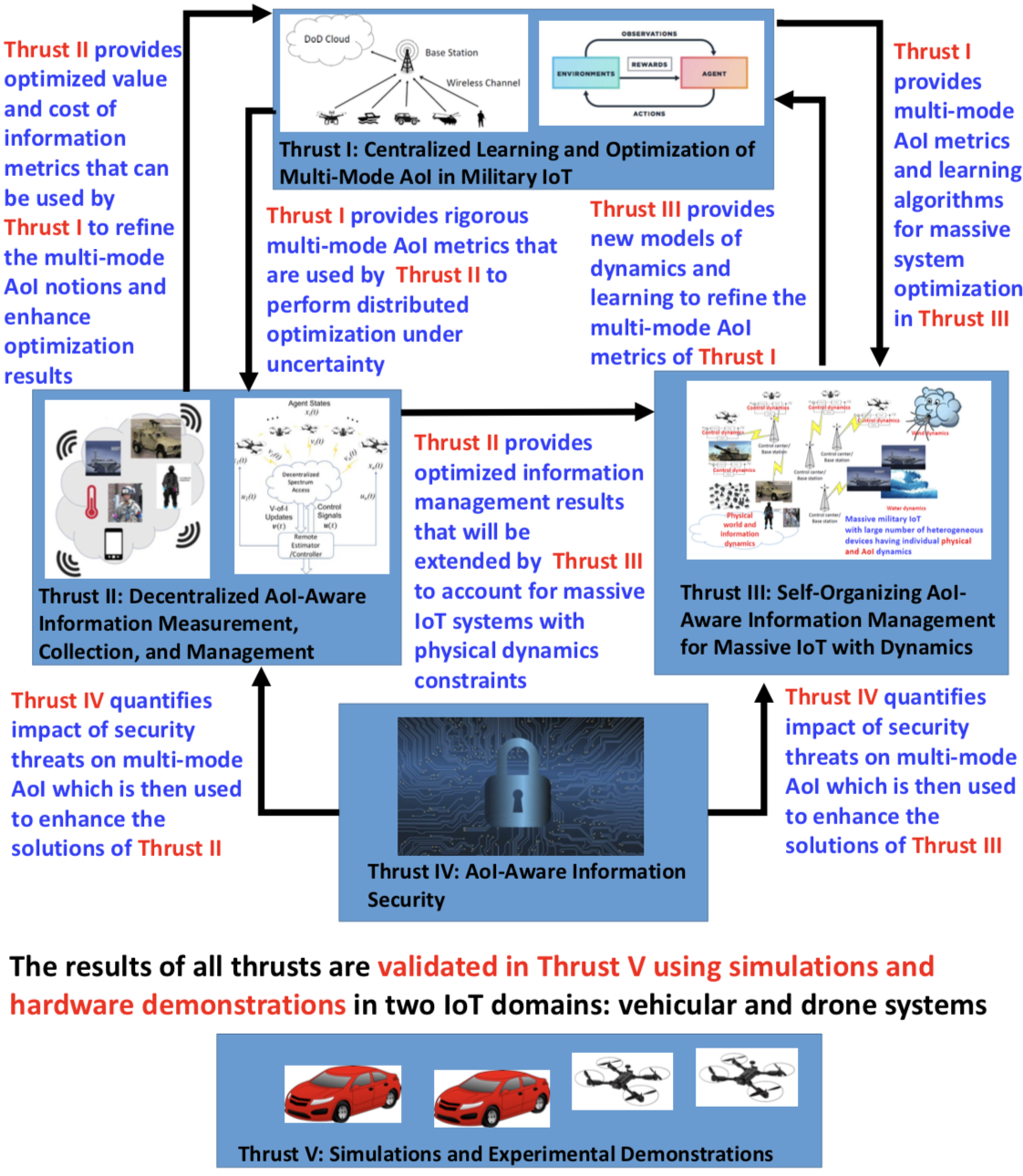Objective and Scope

The goal of this research is to address the military IoT AoI and latency challenges by developing a foundational framework composed of five cogent thrusts that harmonize new notions from information theory, communication theory, signal processing, optimization, control, game theory, learning, and security. This framework enables efficient management of AoI in a dynamic, massive military IoT where the heterogeneous information types and physical world dynamics directly impact how information ages. We start by Thrust I that develops new reinforcement learning, optimization, and information-theoretic approaches to translate the information and physical system dynamics into information whose AoI must be defined using novel multi- mode metrics. This leads to a fundamentally novel latency measure, dubbed multi-mode AoI, that explicitly accounts for the fact that information ages differently in a military IoT. The optimized multi-mode AoI metrics of Thrust I are then refined in Thrust II by quantifying the costs (in terms of overhead latency) for information collection and measurement as well as the value of information. Thrust II will then develop new decentralized optimization and control algorithm to optimize the tradeoff between multi-mode AoI, cost, and value of information. The multi-mode AoI-aware optimization solutions of Thrust II are then extended by Thrust III to massive, self-organizing IoT systems that encompass a very large number of devices, each of which having their own physical dynamics’ constraints, using a fundamentally novel game-theoretic framework. Then, in Thrust IV, the impact of AoI-compromising security threats, such as jamming and replay attacks, is characterized and mitigated. The results of Thrust IV are then used by Thrusts II and III to include security in their objective functions. Finally, Thrust V develops new simulation and hardware testbeds, related to autonomous ground and aerial IoT networks, to validate and demonstrate our framework under real-world IoT constraints.

Thrust I: Centralized Learning and Optimization of Multi-Mode AoI in Military IoT
Leads: Dr. Zheng and Dr. Hou. Major Contributors: Dr. Saad and Dr. Lou.
Thrust Goals. Thrust I has three goals: a) Developing a new fundamental notion of AoI, dubbed multi-mode AoI that exploits the fact that different information can age differently, b) Introducing new solutions to learn this multi-mode AoI within a military IoT network, and c) Developing centralized solutions for multi-mode AoI minimization under realistic military IoT constraints.
Thrust II: Decentralized AoI-Aware Information Measurement, Collection, and Management
Leads: Dr. Eryilmaz and Dr. Reed. Major Contributors: Dr. Zheng and Dr. Hou.
Thrust Goals. Thrust II has three goals: a) Expanding Thrust I’s framework to incorporate notions of value and cost of information with multi-mode AoI, b) Developing dynamic information management strategies for tracking and adaptation to the military IoT information, and c) Understanding the fundamental limits and tradeoffs between measurement collection time (measurement latency) and the accuracy of real-world measurements, in terms of errors and uncertainty.
Thrust III: Self-Organizing AoI-Aware Information Management for Massive IoT with Dynamics
Leads: Dr. Saad and Dr. Eryilmaz. Major Contributors: Dr. Hou and Dr. Reed.
Thrust Goals. The key goals of Thrust III include: a) Developing a novel self-organizing framework based on game theory and learning that enables each IoT device to optimize its control, scheduling, and information management strategies so as to minimize multi-mode VoI and AoI in a fully distributed setting under explicit per device constraints on the physical world dynamics that impact the AoI and the communication and b) Characterizing using mean-field game theory how a massive military IoT system can maintain low latency information update and management, in presence of thousands of distributed, heterogeneous, devices and BSs with individual dynamics.
Thrust IV: Information Security in AoI-Sensitive Military IoT
Leads: Dr. Lou and Dr. Saad. Major Contributors: Dr. Reed and Dr. Eryilmaz.
Thrust Goals. The primary goal of this thrust is to complement the frameworks of Thrusts I-III with new approaches to simultaneously maintain information integrity and freshness while thwarting attacks that target the AoI of the system, such as replay attacks and jamming.
Thrust V: Simulations and Experimental Demonstrations
Leads: Dr. Reed and Dr. Hou. Major Contributors: Dr. Lou and Dr. Zheng.
Thrust Goals. The goal of Thrust V is to validate and refine the solutions proposed in Thrusts I-IV by developing real-world simulators and practical experimental demonstrations. This experimental validation will allow demonstrating our results in real-world situations to show their value and as a sanity check of assumptions made during the formulation of the theoretical results. Success for this experimental demonstration task will depend on several factors: 1) Orchestrating a tightly coordinated team, 2) Developing risk-mitigation strategies including contingency plans, start simple and build complexity, evolutionary milestones, and setting realistic expectations and prudent risk assessment, and 3) Leveraging to the greatest extent possible previously developed software tools and hardware while still accomplishing the proof-of-concept goals of each demo. As each thrust is explored, demos will follow quickly from the initial theoretical development.
